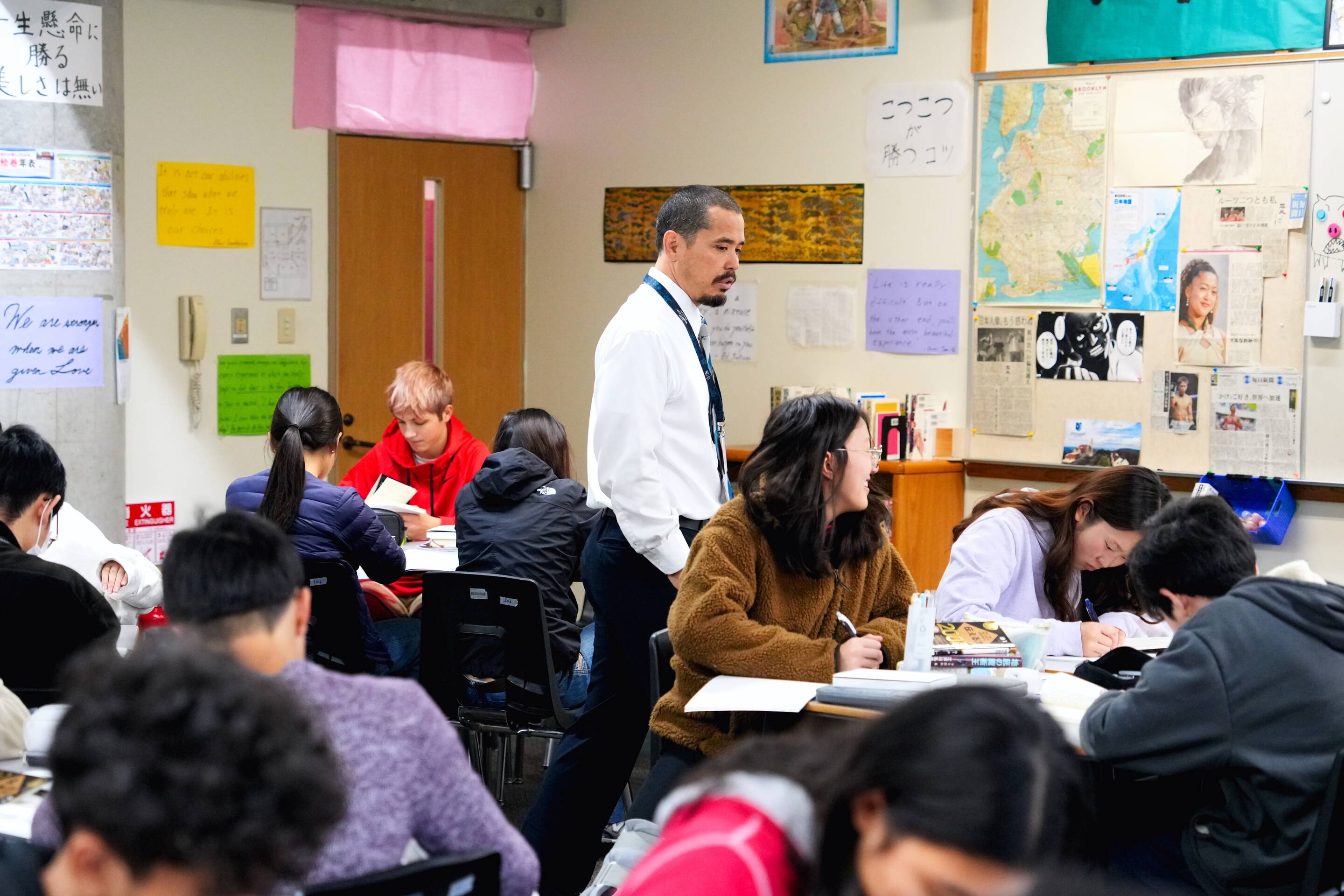Japanese language program expands to help CAJ’s native speakers grow
Back to newsletter
The demographic makeup of CAJ has been shifting for many decades and has continued to shift even more so recently.
Between 2017 and 2025, the number of single-nationality Japanese students in the school increased by 47 percent. Naturally, this means that more native-level Japanese speakers attend CAJ, and also that many students go on to stay in Japan for university and a career. In 2009 and 2010, fewer than 10 percent of CAJ graduates went to Japanese universities, while that number has hovered closer to 35 percent since 2020.

About 10 years ago, CAJ’s high school language offerings included five levels of Japanese instruction, and the courses were geared more towards progressing the Japanese literacy level of non-native speakers. Students took the Advanced Placement Japanese Test in the final level of Japanese class, but the test was not challenging for the students in that class.
Japanese language department head Morris Yaegashi (‘98) discussed with former head of school Anda Foxwell around that time the possibility of adding native-level Japanese courses to the CAJ curriculum.
Yaegashi then created (and taught) a Japanese Literature and Society class for native speakers who were well above the AP Japanese level and wanted to be challenged to improve their Japanese skills. He said the class continued to grow, and demand created the need for a second class: Japanese 20th Century Authors.
“After that second class started, we noticed that we had a group of students that weren’t quite ready for those upper-level classes, but they were still way above AP level,” Yaegashi said. “So we created another year where we prep for the literature classes called Japanese Composition.”

The Japanese department high school has now gradually tweaked the Japanese program to become the original five levels plus a native speaker track that includes four courses, three of which (Japanese Christian Literature, Japanese Literature and Society, Japanese 20th Century Authors) are offered on a rotating basis by year. In middle school, there are five levels, including one literature level exclusively for native speakers.
Yaegashi has added that the skill gap is large between the lower levels and the native track, but that many students have been motivated enough to spend their time doing considerable outside studies to jump from the non-native track to the native track.
“Our school vision includes the phrase ‘serve Japan [and the world for Christ]’ and our students are increasingly staying in Japan for university and work,” Yaegashi said. “So either we say that we are a prep school for the North American curriculum, or we say that we want students to be able to serve in Japan, and we equip them to do so.”
Yaegashi says these courses are properly preparing students to enter Japanese universities and the work force, something that more and more CAJ students are doing. But it’s not all about future benefits.
“Students taking these courses get to understand Japanese from the perspective of Japanese people,” Yaegashi said. “When they study Japanese literature, they are reading books by Japanese people written in Japanese about their daily life and worldview. It’s all native, and they get to hear about Japan directly from the source.”
Here are some thoughts from a couple of class of 2026 seniors who have taken at least three years of courses with Yaegashi in the native track:
Daigo-
“I’ve enjoyed being able to wrestle with the depth of Japanese literature, from classic works to modern authors, and to see how they reflect issues in society and faith. The discussions often go beyond the surface of ‘what does this text say?’ to ‘what does this text mean for us today?’ That depth has been both challenging and rewarding.”
Shiori-
“In Japanese Composition, we were properly taught how to write essays in Japanese, and those lessons have stuck with me even now. In other classes, we write essays pretty often, and for those who’ve taken Composition, it’s definitely less stressful.
Another big part of these courses is reading. Each year, we usually read three to five books as a class, with assigned reading for almost every class. At first, it felt overwhelming, but over time I built up stamina and got used to the workload. It really helped improve my reading skills, and honestly, the books we read are interesting and inspiring. Putting in the effort is totally worth it.”
 About 10 years ago, CAJ’s high school language offerings included five levels of Japanese instruction, and the courses were geared more towards progressing the Japanese literacy level of non-native speakers. Students took the Advanced Placement Japanese Test in the final level of Japanese class, but the test was not challenging for the students in that class.
About 10 years ago, CAJ’s high school language offerings included five levels of Japanese instruction, and the courses were geared more towards progressing the Japanese literacy level of non-native speakers. Students took the Advanced Placement Japanese Test in the final level of Japanese class, but the test was not challenging for the students in that class. The Japanese department high school has now gradually tweaked the Japanese program to become the original five levels plus a native speaker track that includes four courses, three of which (Japanese Christian Literature, Japanese Literature and Society, Japanese 20th Century Authors) are offered on a rotating basis by year. In middle school, there are five levels, including one literature level exclusively for native speakers.
The Japanese department high school has now gradually tweaked the Japanese program to become the original five levels plus a native speaker track that includes four courses, three of which (Japanese Christian Literature, Japanese Literature and Society, Japanese 20th Century Authors) are offered on a rotating basis by year. In middle school, there are five levels, including one literature level exclusively for native speakers.